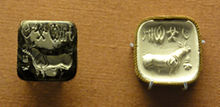
The stamp seal (also impression seal) is a common seal die, frequently carved from stone, known at least since the 6th millennium BC (Halaf culture[1]) and probably earlier. The dies were used to impress their picture or inscription into soft, prepared clay and sometimes in sealing wax.
The oldest stamp seals were button-shaped objects with primitive ornamental forms chiseled onto them.[2] The stamp seals were replaced in the 4th millennium BC by cylinder seals that had to be rolled over the soft clay to leave an imprint.[1] From the 12th century BC the previous designs were largely abandoned in favor of amphora stamps.[3] Romans introduced their signaculum around the first century BC;[3] Byzantine maintained the tradition in their commercial stamps.[4]
In antiquity the stamp seals were common, largely because they served to authenticate legal documents, such as tax receipts, contracts, wills and decrees. They are extensively researched because[citation needed] they were usually carved with important "themes" of the society that produced them, rather than with an ordinary signature.[citation needed]




